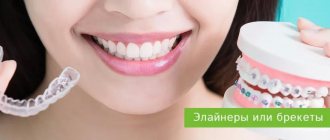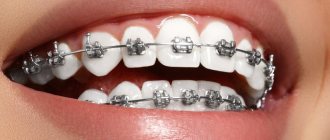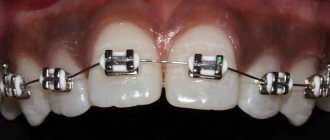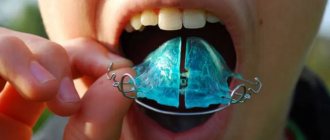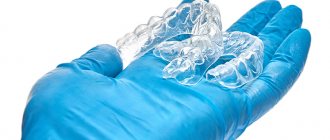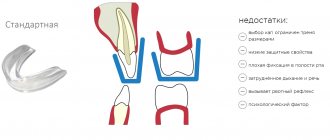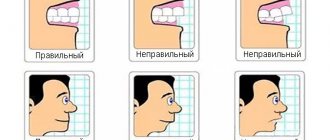Mouthguards and braces are special designs that are used to correct irregularities in the dentition. Both methods of orthodontic treatment are quite effective and each of them has its pros and cons. Let's find out how mouthguards differ from braces and what is better to choose for bite correction.
In this article
- What are mouth guards and braces: design features
- Indications
- Installation for children and adults
- Aesthetic factor
- Wearing comfort
- Rules of care
- Diet
- Duration of treatment
- Efficiency
- Price
- Braces or mouthguards - which is better?
Dental problems such as uneven teeth or misaligned bites can be treated using a variety of methods. The main ones are braces and mouth guards. The former have been used for almost 70 years, the latter began to be used relatively recently, about 15 years ago, as an alternative to orthodontic braces. What are their differences, advantages and disadvantages? These methods of teeth straightening differ in several ways:
- features of the design used;
- indications;
- installation options for children and adults;
- aesthetics;
- wearing comfort;
- rules of care;
- the need to follow a diet;
- duration of treatment;
- efficiency;
- price.
Let's look at each point separately.
What are mouth guards and braces: design features
Braces are orthodontic structures that consist of an arch and several clasps and are used to correct malocclusions. The arc has a memory effect. After installation on the teeth, it gradually returns to the original state specified during the diagnosis, and due to pressure on the jaw, it aligns the dentition and corrects the bite. There are many varieties of such structures that differ in function, strength, color, etc. However, their operating principle is the same.
Mouthguards (aligners, trainers) are orthodontic attachments made of non-oxidizing metal or polymers, used to correct the bite and acting on the principle of gentle gradual pressure on the teeth. They work exactly the same as braces. But mouthguards differ from braces in that they are lighter and invisible to others. In addition, they are removable; they are removed before eating or brushing your teeth. You cannot remove braces yourself; they are installed for several months or years.
After diagnosis, the dentist tells the patient about the advantages of each teeth straightening method and, if possible, allows him to make a choice. Based on his lifestyle, personal preferences and financial capabilities, a person determines what suits him best - braces or mouth guards.
How much does teeth straightening cost?
The price of teeth straightening is perhaps the key factor that forces patients to choose a treatment method. Before you see a doctor, you should compare the prices of different clinics and find out how much this or that dentistry asks for teeth straightening, what methods it uses, and for which procedures you will have to pay extra separately. It must be remembered that prices for teeth straightening for adults may be higher than for similar services for teenagers.
The iOrtho clinic network provides high-quality services for correcting malocclusion with Invisalign aligners, sign up for a consultation now!
Indications
Braces are prescribed more often because mouthguards as a treatment method include a small list of indications. They are unable to correct serious defects.
They are used to eliminate:
- diastema and three between teeth;
- teeth twisted by more than 6 mm;
- rotation of teeth - rotation around its axis;
- pathological inclination of dental units;
- open, distal, mesial and crossbite.
However, mouthguards are not suitable in cases where molars or canines are rotated, as well as in cases of posterior bite pathology.
With the help of braces, you can get rid of almost any anomaly associated with the incorrect placement of teeth. Orthodontic braces are indispensable for:
- crowded teeth;
- defects of jaw development;
- restoration of dental density;
- complex malocclusion pathologies, for example, dystopia.
Thus, braces are suitable for the treatment of all malocclusion pathologies. Mouth guards can be used as an alternative to orthodontic braces for minor defects.
Seriously speaking, it is best to be treated with aligners
Why?
Yes, because they have a huge number of advantages over braces. There are only a few difficult dental pathologies that aligners cannot handle. But all other problems of crooked teeth are perfectly corrected by aligners! Star Smile is represented by orthodontists in more than 70 (!) cities of Russia. And we guarantee you the most comfortable prices for treatment with aligners! To make sure of this, leave a request for a FREE consultation with an orthodontist in your city. Do you want to visit an orthodontist completely free?
Installation for children and adults
Braces can be installed on molars at almost any age. The dental system in humans is formed until approximately 17-18 years of age, and the final bite is formed by 12-14 years of age. It is best to get braces during adolescence, as children's dental tissues are more pliable. Staples are also effective in treating adults, but preparation for their installation will require more time and effort. In addition, the healing process will be longer.
Trainers can also be prescribed to both young patients, even those with baby teeth, and older ones. However, it is worth considering that mouth guards are a removable device. If an adult can control himself, then the child will have to be constantly monitored so that he does not remove the aligners if discomfort occurs.
Typically, plates are used when the child’s molars are just erupting, if there is a risk of their improper growth. After the bite is formed, it is better to install braces. As for adults, their choice is determined primarily by indications, and only then by their own preferences.
Time frame for bite correction
Treatment with braces is a long and painstaking process that requires periodic monitoring by a dentist. Teeth cannot move faster than 1 mm in a month.
To completely correct a broken bite, orthodontists recommend wearing the device for 1.5-2 years. Each case is individual, so if an additional defect is observed, this period increases.
Aligners are often installed after braces treatment has ended. The duration of wearing this system is approximately equal to the period of treatment with metal structures - from 8 months to 2 years. This is due to a number of factors:
- type of malocclusion;
- age of the patient – treatment will be faster for children;
- severity of jaw defects.
It should be concluded that installing mouthguards instead of berekets is possible only in rare cases. The main indication for wearing them is completion of treatment after straightening the dentition.
Aesthetic factor
Many people, especially children, are embarrassed to wear braces, have complexes and hide their smile during communication. This has a very negative impact on self-esteem and building relationships with other people. However, orthodontic structures looked unaesthetic 10-20 years ago. Today, even metal structures are very neat and do not spoil the appearance. In addition, you can order ceramic or sapphire braces. They cost more, but are almost invisible on the teeth. There are also lingual braces that are placed on the inside of the teeth. They are completely hidden from others.
In terms of aesthetics, mouth guards are superior to braces; they are almost invisible, as they are made of translucent materials.
How much does it cost to install mouth guards?
The total cost of bite correction will depend on the number of trays used. The treatment plan is drawn up by the doctor after diagnosis, which includes:
- panoramic shot of the jaws;
- teleroentgenogram of the skull;
- making models of jaws from casts.
The more significant the deviations from the normal position of the teeth, the longer the treatment period will be. The doctor will calculate the advisability of using mouth guards and, in case of serious malocclusions, will offer alternative options - the use of braces and orthodontic devices. The most popular aligners for correcting bites are from the Invisalign brand from the international manufacturer Align Technology.
Wearing comfort
You need to get used to braces and mouth guards. The adaptation period after installation of orthodontic structures lasts about 5-15 days. At this time, the patient may experience discomfort and pain. In addition, there is a risk that metal structures will rub the mucous membrane, in rare cases this leads to the development of inflammation of the soft tissues. Braces also have a significant impact on diction, especially at the very beginning of wearing them. Even lingual braces cause speech distortion. Each time after tightening the arch there will be a new period of adaptation, but not as long as the first.
Mouthguards are much more comfortable, they do not rub the oral mucosa and do not lead to deterioration of diction. However, trainers significantly increase the size of the teeth, which is accompanied by mild discomfort. They usually get used to it quickly. During this period, it is important to be patient and not remove the mouth guards several times a day, otherwise the treatment will be delayed.
Additional doctor visits and procedures
| Additional doctor visits and procedures | ALINERS | BRACKETS | VENEERS |
| Frequency of doctor visits | Once every 4-6 weeks | every 2 weeks | after fixation once 6 months |
| Probability of root canal treatment | low | low | high |
You should most rarely visit a doctor after installing veneers, most often - every two weeks - when installing braces. Aligners are a relatively comfortable visit once every month to a month and a half.
Rules of care
In terms of hygiene rules, mouthguards compare favorably with braces. It is easier to care for the aligners; they are removed before eating and brushing your teeth, and you need to clean them with a regular toothbrush with soft bristles. The trainers are washed with water and stored in a container. With braces everything is much more complicated. Hygienic procedures will take quite a lot of time, otherwise the risk of developing caries increases. To fully clean your teeth and braces from food debris and bacteria, you will have to devote at least 10 minutes to hygiene in the morning and evening. You also need to purchase special care products:
- toothbrush with V-shaped bristles: CURAPROX Ortho;
- brush for cleaning locks: Curaprox CPS 10, Biorepair Scovolini Interdentali Cilindrici;
- dental floss with a hard end: Mirafloss implant chx;
- disinfectant rinses: Biorepair Mouthwash;
- irrigator: Donfeel Donfeel OR-820D Compact, Revyline RL 100, Panasonic EW-1411, Revyline RL 200XL.
You should brush your teeth in the morning and evening, use a brush after every meal, and floss after eating fibrous foods. The mouthwash can be used several times a day, and irrigators - at least 2-3 times a week.
Type No. 5: remineralizing
In appearance and purpose, this option is exactly the same as the previous one, only in this case it is not a whitening composition that is placed in the trays, but ones that strengthen the enamel, increase its resistance to caries and destructive external influences, and reduce sensitivity - based on fluoride, calcium and others minerals.
Remineralizing therapy or fluoridation is carried out one-time or in courses. Place of procedure: both in the dental office and at home. Mouthguards can be disposable or reusable, standard or individually designed, and even thermoplastic (you can order these on the Internet, but doctors do not recommend it, because this option can do more harm than good).
Diet
There is no need to change your diet after installing the mouthguard, since the plate is removed before eating. With braces you will have to stick to a diet. In the first days after fixing the braces, as well as after tightening the arches, you can only eat liquid food. Subsequently, you need to give up solid foods: hard meat, nuts, apples, carrots, etc. They should be ground or ground before eating. It is also necessary to limit the consumption of sweets, sticky foods and drinks with coloring substances: soda, coffee and tea.
After installing braces, it is important not only to exclude certain foods from the diet, it is also recommended to observe the temperature regime. You should not eat food that is too cold or too hot. It negatively affects the condition of the structure and enamel.
Many people mistakenly believe that braces damage teeth, since a large number of bacteria accumulate under them. However, germs can only appear under the arc, and if you take care of hygiene, they will not cause any harm. The locks themselves are sealed tightly, so neither microorganisms nor food debris can get under them. The part of the tooth to which the lock is glued, on the contrary, is reliably protected from external influences.
Type No. 3: mouthguard trainer
This design, unlike the two previous ones that we described earlier, is more massive, is fixed on both rows of teeth at once, depriving its owner of the opportunity to speak and smile. And it cannot be called aesthetic and inconspicuous at all. However, the trainer belongs to the category of mouthguards or mouth guards (both options are correct).
This type of orthodontic appliance is mainly prescribed to children to correct bite pathologies, and at the same time to correct functional disorders and bad habits that contribute to the development of defects in the dental system - for example, incorrect type of swallowing and breathing, incorrect position of the tongue, the child’s desire to constantly put it in his mouth fingers and foreign objects.
Duration of treatment
The duration of treatment for malocclusion pathologies using mouthguards and braces is the same. However, trainers are not installed for serious disorders, so they usually have to be worn for 8-12 months. If you get braces for exactly the same dental disease, the correction will also last about a year. Severe curvatures are corrected within 1-3 years.
The effectiveness of treatment largely depends on how the patient follows the doctor’s recommendations. If he doesn't have good hygiene while wearing braces, doesn't eat well, or (if he wears a plate) removes his mouth guard too often, complications can arise. As a result, the teeth straightening process will be delayed. In addition, you will have to pay for additional services: making a new design, caries treatment, etc.
Installing a mouthguard to straighten teeth
Aligners are much easier to install than braces, and they are also much more comfortable to wear and adjust. This procedure usually takes place in 3 stages.
- Diagnostics.
The doctor examines the patient for contraindications and diseases that must be eliminated before starting treatment. An accurate cast of the jaw is then made, which will serve as the basis for creating the mouthguards. - Manufacturing.
All data - x-ray, tomogram, jaw model - are sent to the company’s laboratory and processed in a special program. After this, a special device produces the required number of aligners to straighten the teeth. - Installation.
A person receives a set of products and recommendations for use. The specialist helps you put on the device, prescribes medications if necessary, and then sets a date for the next appointment. You will have to visit the orthodontist only once every one and a half to two months to monitor changes. The aligners do not require correction; the dentition is corrected by changing the set every two weeks.
Efficiency
The effect lasts for a long time, both after braces and after mouth guards, but only if the patient follows the rules of the retention period. This is the final stage of any orthodontic treatment. After removing braces or aligners, you need to wear other mouth guards - retainers, which are slightly different from corrective ones. This device allows you to consolidate the result.
Retainers must be worn for the same period for which braces or mouth guards were installed. The fact is that after removing them, the load on the teeth is greatly reduced, so they can return to their previous position. It is necessary to strengthen the ligamentous apparatus around the tooth roots. Retainers allow teeth to adapt to new conditions.
Aligners: what are these devices?
Aligners are transparent orthodontic trays made of thermoplastic polymer composite. The difference between braces and aligners is that the pressure on the dental units is not exerted by clasps connected by an arc, but by special activators inside the device, which set the impulse to shift the dental unit. To achieve the desired results, a set of correctors is made of different thicknesses, shapes, and sizes.
Each pair is created taking into account the predicted trajectory of displacement of the dental unit to a given position. The aligners change sequentially from larger to smaller sizes (every 2 weeks). All aligners in the set are numbered, so the patient knows exactly which system to use at a certain period. Wear the corrective device for 20-22 hours
per day, every day, removing only for food and hygiene care.
Those who want to choose aligners instead of braces need to think carefully about how responsibly they treat treatment. Corrective devices often cause discomfort and pain, especially when changing the arch or cap. And if it is impossible to remove the bracket system and you have to endure adaptation, then the aligners can be removed at any time or “forgot” to put them on. This increases the correction time, and often reduces treatment to zero. Therefore, aligners are suitable only for patients who are truly motivated to achieve results. For those whose self-discipline is lacking, it is better to choose braces.
Braces or mouthguards - which is better?
So, what should you choose - mouth guards or braces to straighten your teeth? This depends on several factors, the main one being medical indications. Let us list once again the main advantages and disadvantages of braces and mouthguards.
Pros of braces:
- high efficiency;
- suitable for almost any pathology;
- relatively low cost.
Cons of braces:
- long installation;
- difficulty of care;
- unaesthetic;
- long-term adaptation.
Pros of the mouth guard:
- aesthetics;
- do not impair diction;
- no diet;
- simple hygiene rules;
- hypoallergenic.
Cons of the mouth guard:
- high cost;
- not suitable for all disorders;
- long production;
- risk of loss.
Another important factor to consider when choosing a malocclusion correction method is related to motivation. You need to prepare for the fact that after installing braces or mouth guards there will be discomfort and even pain. You need to be patient for a little while so that the oral cavity gets used to the foreign object. A person who is prescribed aligners may want to remove them. Over time, he will do this more and more often, and because of this, the effectiveness of the treatment decreases. It can last for several years without bringing any results. Braces in this context have an important advantage: they cannot be removed by yourself, so you will have to come to terms with and comply with the orthodontist’s requirements.
Indications for installation of bracket systems
Braces are required for more than just correcting malocclusion. They can also be useful for treating other serious pathologies of the oral cavity, when other methods are simply powerless. For example:
- Complex and very advanced cases of jaw deformation.
- Increased crowding of a row or, conversely, its sparseness. As a result of this pathology, the roots of the teeth can be exposed, which causes the patient severe discomfort in everyday life.
- Incorrect development of the jaw bone.
- Deep bite.
- Dystopia and so on.
Advantages and disadvantages
Of course, if braces were ineffective, they would not have been used by the most experienced orthodontists around the world for many decades. These systems demonstrate excellent results in correcting even the most complex malocclusion pathologies.
However, like any treatment method, there are pros and cons.
Main advantages:
Maximum efficiency and reliability.
Wide scope of use. Braces can be used to correct minor curvatures or in cases of serious irregularities.
During treatment, the patient regularly visits his doctor, so the entire process is carried out under the strictest control. If necessary, the doctor can make adjustments to the prescribed action plan, fix the breakdown, or give the necessary advice.
If we compare treatment with braces with the installation of mouth guards, then the cost is significantly lower. This usually plays a decisive role in the choice.
Unfortunately, braces have a number of disadvantages:
- When vestibular structures are installed, the smile loses its former attractiveness. While braces can look bulky and heavy, metal options are dark in color so they stand out against the white enamel of the tooth. As a result, a person may feel constrained and insecure when communicating with colleagues and friends.
- Manufacturing and installing the system itself takes a lot of time. Fixation takes an experienced specialist from 1 to 3 hours, depending on the complexity of each specific case.
- Non-simultaneous correction of all units in a row.
- Risk of damage and staining of enamel. As a result, white carious spots, cracks, etc. may appear.
- The braces are quite large and have sharp edges. All this can lead to accidental injury to the mucous membrane, inner surface of the cheeks and tongue. This applies to both vestibular (classical) systems and those installed on the inside of the row (lingual).
- Also, during the adaptation period (from several weeks to several months), the patient may experience diction problems.
Types of bracket systems
A lot depends on the material from which orthodontic structures are made, as well as on the method and place of their fixation. Braces are lingual and vestibular, ligature and self-ligating. Depending on the material, the following are distinguished:
- Metal. They are considered the most effective and fastest due to their strength and reliability. At the same time, they look rather awkward and cumbersome on the teeth, which attracts the attention of others. They are able to cope even with complex bite pathologies. They cost less than their analogues.
- Plastic. They look more attractive, but are less durable. Their cost is approximately the same. Children really like it, as it is possible to make colored or shaped versions.
- Ceramic. They are practically invisible on the teeth, but can become stained when drinking large amounts of strong tea, coffee or red wine. Due to the porous structure of the material, plaque accumulates more actively on them, as a result of which, even with regular cleaning, braces can lose their original appearance.
- Sapphire. The most aesthetically attractive models are made from artificially grown sapphire crystals. They are absolutely invisible on the teeth, as they are completely transparent and imitate the shade of your own teeth. Moreover, this design option is the most expensive, so not everyone can afford its installation. It is important to note that the treatment period with such braces will be longer than with metal options.
previous post
Internal braces
next entry
Which system to choose
No one except the orthodontist can decide which device is suitable for the patient. The selection of the system is carried out strictly individually, taking into account the characteristics of the clinical situation.
In the most difficult cases, it may be necessary to use two types of mechanisms at once. So, a person wears retainers on his teeth around the clock, and at night he additionally puts on a mouth guard to increase the pressure created.


